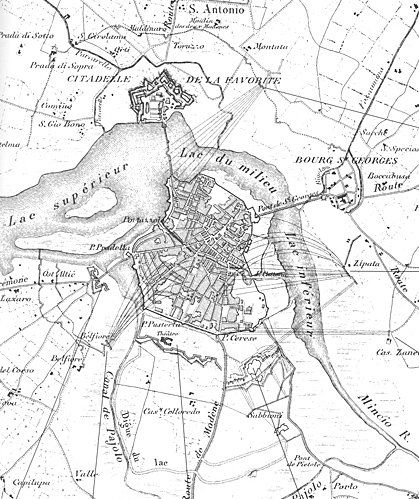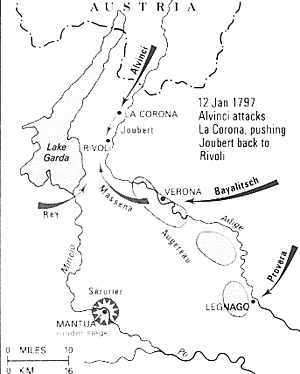On March 27th 1796, General Napoleon Bonaparte assumed the command of the Army of Italy. He was accompanied by General Berthier, who was his chief of staff until 1814. Napoleon had 37,000 troops under his command, who were deployed on a 60-kilometre front in the Ligurian Alps, from Genoa to the north of Nice. Facing these troops were 25,000 Piedmontese and 28,000 Austrians. The condition of the French troops at this time was not good. They were short on rations, there uniforms were in tatters, many men were lacking boots, they were short 1,000 muskets, and the morale was rock bottom.
But when Napoleon came, he won over his soldiers by providing partial pay and strong leadership. Bonaparte resolved to break through into the rich Lombard plain, dangling the prospect of loot before his ragtag force. His decisiveness impressed his three senior generals - Augereau, Serurier and Massena - whose morale before Napolean came was as low as the troops'.
As Napoleon planned his offensive, Austrian and Piedmontese armies were deployed to block the several exists from the parallel valleys leading north. Napoleon's plan was to severe the Piedmontese armies from their Austrian allies, and then using superior forces at the point of attack, destroy both the Piedmontese and Austrian forces seperately and in detail.
After twelve days of continuous action, from 10th April to 22nd April, he severed the Piedmontese from the Austrians. The Austrian Army was driven west and north of the Po river, while the Piedmont signed an armistice with France. The armistice surrendered three key Piedmont fortresses and gave France free use of its territory.
Well Fed and Ready For More
His men were now well fed, paid in cash and loot, and fully supplied. His rival, General Beaulieu, the Austrian commander, planned to defend Milan by positioning Austrian forces in depth along the three northern routes of the Po, with the river and the town of Piacenza protecting his flank.
Napoleon sent two of his divisions against the Austrian front as a feint, and made a forced march of 115 kilometres in two days with the rest of his army along the south side of the Po. He was not restrained by neutral states and crossed the river at Piacenza. This strategic manoeuvre turned all of Beaulieu's river lines and compelled him to withdraw further east across the Adda to the Mincio River. He did this with a 7,000-strong rearguard covering the Adda bridge at Lodi.
Lodi
On May 10th, Bonaparte launched an attack column, supported by a 30-gun artillery barrage across the river. When the column stalled, General's Berthier and Massena, along with several other senior commanders rushed forward and urged the column on, while Napoleon's cavalry threatened the Austrian rear. But the majority of the Austrians got away. Five days later Napoleon occupied Milan, while Beaulieu retreated into the Tyrol and Venetia.
 General Beaulieu left behind 15,000 men to defend Mantua, a key
and strong fortress. On the Directoire's order Napoleon drove south to
force Modena, Parma, Tuscany, the Papal states and Naples into neutrality
and more importantly to extract riches. This expedition did extract big
riches but it also gave time to the Austrians to field a new army of 55,000
men, commanded by the 72 year old General Wurmser.
General Beaulieu left behind 15,000 men to defend Mantua, a key
and strong fortress. On the Directoire's order Napoleon drove south to
force Modena, Parma, Tuscany, the Papal states and Naples into neutrality
and more importantly to extract riches. This expedition did extract big
riches but it also gave time to the Austrians to field a new army of 55,000
men, commanded by the 72 year old General Wurmser.
From July 1796 to January 1797 the war was dominated by two strategic factors. The first was that the French armies in Germany were contained and then defeated and driven back across the river Rhine by Archduke Charles. The second strategic factor was the fortress of Mantua. Mantua was a strong position which dominated the gateway to Lombardy and the passage into the Venetia and Tyrol. The defence here by the Austrians was very tenacious. As long as Mantua held out, Napoleon could not advance.
He had a total of 45,000 troops of whom 10,000 were tied up around Mantua, and the rest had to cover the 130 kilometres of Alpine passes. Therefore, Napoleon had to stand on the defensive. He concentrated his forces to defeat four Austrian attempts to relieve the fortress. General Wurmser attacked in July with two columns which advanced along opposite shores of Lake Garda, the third came down from the Brenta valley. The third column was supposed to unite south of the lake to march on Mantua. But Napoleon, concentrating on interior lines, attacked the enemy columns while they were still separated, striking first at one and then the other. General's Massena's division fought two engagements and one battle in a week, from 29th July to 5th August, while covering 160 kilometres. He destroyed one column at Lonato on 4th August, which helped Napoleon to defeat Wurmser at Castiglione the next day.
Relief of Mantua and Rivoli
The next Austrian advance came in early September. Wurmser's main force moved down the Brenta valley while a second Austrian force, under General Davidovich marched down the east side of Lake Garda. Napoleon using the same tactics as before and struck Wurmser's rear near Bassano and pushed him into Mantua.
Now the Austrians, reinforced by troops from Germany, attacked a third time to relief Mantua. Under General Alvinczy, 30,000-strong Austrians moved west across the Venetian plain on Verona, while Davidovich with about 18,000 men came down the Adige valley. On November 1st, Alvinczy's advance began and reached Caldiero, 15 miles west of Verona. On November 12th, his forces repulsed a frontal attack by Napoleon. Meanwhile Davidovich had pushed the weak French forces under Vaubois down the Adige. But his advance stalled before the Rivoli plateau.
 Napoleon realized that his position would become critical if the Austrians
forced the Rivoli position, so he attacked the Austrian left and rear by
crossing the Adige. The battle of Arcola followed from 15th of November to
the 17th. The Austrians fought hard but Alvinczy, after losing a quarter of
his troops, lost his nerve and withdrew. French losses were also high. Nine
French generals were killed in this battle. On November 17th, Davidovich
finally attacked Rivoli, but now Napoleon could turn against him and by
November 19th the Austrians were in full retreat.
Napoleon realized that his position would become critical if the Austrians
forced the Rivoli position, so he attacked the Austrian left and rear by
crossing the Adige. The battle of Arcola followed from 15th of November to
the 17th. The Austrians fought hard but Alvinczy, after losing a quarter of
his troops, lost his nerve and withdrew. French losses were also high. Nine
French generals were killed in this battle. On November 17th, Davidovich
finally attacked Rivoli, but now Napoleon could turn against him and by
November 19th the Austrians were in full retreat.
By the end of year 1796, the French armies controlled much of Italy, while the Austrians still held Mantua and the alpine passes which led to their Austrian heartland. By now, General Alvinczy had been reinforced to 45,000 troops. He was planning his fourth relief attempt against the Army of Italy.
Another Austrian Advance
His plan was to attack in three columns. One force was to advance from Padua against Augereau around Legnago. The second force would come from Vicenza against Massena at Verona, while the third would come from Trent against General Joubert's division. Austrian attack on Verona was repulsed but Alvinczy on the same day had driven Joubert back to Rivoli. Napoleon ordered Joubert to hold on all costs and he moved and concentrated his troops at Rivoli. Joubert fought gallantly and managed to repulse several Austrian attempts to envelop his flanks.
At 6 a.m. Massena's division arrived after marching for 40 kilometres over ice-covered roads. This and other units which arrived gave Napoleon 23,000 men and 40 artillery guns to fight 28,000 Austrian who had 90 guns. After heavy fighting the Austrians were first repulsed and then routed. In all, the Austrian Army lost 12,000 men and much of there artillery. It was a clear defeat for the Austrians. General Massena moved his force 60 kilometres south and intercepted and then destroyed the Austrian force trying to make it to Mantua. With all hope of relieve gone, the Mantua garrison surrendered.
After some time Napoleon started his strategic offensive into Austria itself. He sent Joubert to the Brenner Pass to cover his left flank and himself crossed the Tagliamento marching towards the Tarvis Pass. All Austrian resistance here collapsed. Archduke Charles, who had earlier defeated the French Army in Germany, now was summoned to rally troops but was unsuccessful. Bonaparte had advanced deep and his position was vulnerable. Joubert had run into strong Austrian resistance in the Tyrol and there was a local rising in Venetia therefore his lines of communications were vulnerable. Still he moved on to Leoben in Styria while Massena's force was at Bruck, only 160 kilometres from Vienna.
Campo Formio
On April 18th Bonaparte negotiated an armistice with the Austrians. After further negotiations, the Peace of Campo Formio was signed on October 17th. Austria ceded Belgium and Lombardy, accepted French rule on the left bank of the Rhine and recognized the French satellite repulics in Italy. They also let French control of Venetian possessions in the Adriatic, which is a foothold in the eastern Mediterranean. In return the Austrians received the Venetian mainland, including Venice, and its fleet.
After these campaigns, Napoleon Bonaparte became one of the leading generals of the French Republic with a strong following in the Army. He would never forget his first campaign and the officers and men who fought it.
Back to Table of Contents -- Warfare in History Newsletter 1
Back to Warfare in History Newsletter List of Issues
Back to MagWeb Magazine List
© Copyright 2003 by Shahram Khan.
This article appears in MagWeb (Magazine Web) on the Internet World Wide Web.
Other military history articles and gaming articles are available at http://www.magweb.com